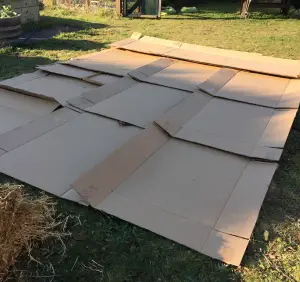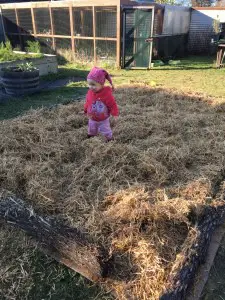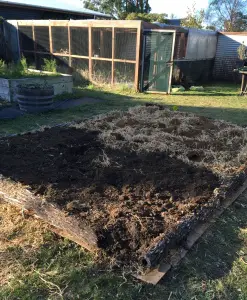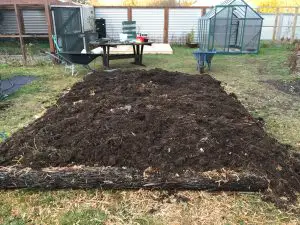Contents
Although it’s still Winter here right now, I’m already starting to think ahead to Summer.
Particularly the potatoes to be grown in Summer, to be more precise.
Potatoes are one of my favourite crops to grow. You can’t beat the satisfaction of popping a few seed spuds in the ground and discovering how well they’ve spawned when you start digging them up in the Summer.
Every year, a few days before Christmas, we grab a garden fork and a couple of fish boxes and start raiding the potato patch. It’s become a tradition that we always eat a lovely big helping of our own fresh baby potatoes for Christmas dinner.
And every year I wish we had grown more, so we could keep eating them for many more weeks to follow.
We have both small and large garden boxes but still nothing big enough (in my opinion) to grow as many potatoes as we can eat.
So, with an eye on the prize (lots of potatoes!), I decided it was time to expand the edible garden plot again. The main criteria being that it had to be a reasonably large garden so raised garden boxes weren’t really an option (too expensive and to hard to reach the centre of when larger) and I would be doing most of the work myself in a pretty short timeframe (toddlers keep you really busy!!) so I didn’t want to spend too long digging over the lawn and killing it off etc.
A ‘No Dig’ garden met the criteria perfectly.
Simple to install, able to be expanded as large as you like, and ready to go in a reasonably short timeframe.
No Dig Garden – The Basics
A ‘no dig’ garden is a no cultivation required garden created on top of an area, rather than being dug into that area.
Using layers of various organic materials you build the garden up to create the perfect growing area without having to turn, break and till what was probably previously a big spread of lawn.
Not having to expend effort digging and tilling is definitely one great benefit of no dig gardening, but ‘no dig’ also benefits the garden you create.
Digging a garden is something we normally just expect to do. When you garden, you dig. Right? Well it turns out that digging isn’t always for the best. The main purpose of digging is to remove weeds and other perennials and bring to the top the usable soil. But digging can actually disturb the natural balance of things, upsetting all of natures hard work and displacing beneficial microbes and inhabitants. Digging is great if you have layer upon layer of rich, healthy soil, but most of us don’t have these conditions and digging down to find them will just result in a lot of effort for not a lot of gain.
So why not create the lovely rich layers you want without the effort and disruption?
Creating Your No Dig Garden
The ideal time to start creating your no dig garden is during the Autumn or early Winter so the layers have time to break down over the coming months.
There are a lots of different lists of what materials to use out on the internet, but in having browsed through a few and then speaking with my super knowledgeable garden centre guy we came up with just a few easy to find materials that would do the job perfectly.
Materials
- Cardboard , old newspapers or old carpet
- Blood and bone
- Grass clipping (not sprayed or gone to seed)
- Dry leaves
- Pig or horse manure (well rotted)
- Pea Straw or Lucrene Hay
- Compost
How To Create Your ‘No Dig’ Garden
- Start by locating an area of your garden where you can build your new plot. Somewhere that gets at least 6 hours of sun a day is best, and where water drains away without trouble. If the area you are using has been heavily compacted over time use a garden fork to gently prise open small gaps in the ground to allow for drainage.
- To help break down the lawn you’re covering with your garden, sprinkle some of the blood and bone over it and water it in well. You want the area you’re starting with to be wet before you lay your no dig garden layers down so that the covered area doesn’t draw the moisture away from your new garden bed.
- Lay out your cardboard (cut box tape so they lie flat), newspapers or carpet so that they cover the whole area you want to use. If you’re using newspaper use 10-20 sheets at a time so that it’s thick and with which ever bottom layer type you use overlap the edges by approximately 10 cms on all sides so that there are no gaps for weeds or grass to grow through.

- Water well so that the cardboard or papers are completely soaked through.
- Now is a good time to decide if you want any edging or not. Railway sleepers, punga logs, old posts or bricks are all good options.
- Next break up the pea straw or hay and spread it across the full area. If you have a little helper who is willing to stamp it all down for you let them go for it! : )

- On top of the straw/hay, spread the manure so that all of the hay or straw is covered.

- Next add in layers of leaves, clippings and compost. Make sure to spread a good layer of well broken down compost or a fertiliser as the last layer and make sure it is well covered.
- Now we want to do it all again.
- Repeat steps 6 – 8, adding the layers one on top of the other until you have two layers of each type of material on your new garden. By the time all our layers were added the garden was about 50cms in height.

- Water it all in really, really well.
- If you have access to a collection of worms (i.e. in your worm farm), consider relocating a handful to your new garden bed. They will do wonders for your soil and have no complaints about their lovely new spot.
- Now step back for a few weeks. Let the whole thing settle and start to break down, watering each day to prevent the garden drying out.
Planting In Your No Dig Garden
Once your garden has had time to bed down you can start planting. If you want to start planting in your no dig garden immediately it’s a good idea to add a bit of extra soil or compost in the spaces where you’re planting so the plants or seeds get immediate nutrition, while your no dig garden layers break down.
As I mentioned above, we’re using our ‘no dig’ garden for potatoes so in the next month or so I will be planting our seed potatoes and then adding extra soil to our garden to mound up around the potato tops.
By Spring all the layers should have had enough time to decompose and create a lovely rich, nutritious soil, perfect for growing in.
As your layers continue to break down over the growing season you will want to add in additional organic layers and compost. So, after your growing season is finished in the Autumn, add in new layers of materials listed above and let them break down over Winter so you can start all over again in the Spring.
For absolute expert advice on this subject, check out the below book by Esther Deans, the originator of the no dig garden.
Want to know more about gardening ?
Fill in your email address in the form below and you'll receive all the latest updates directly in your in-box.
Thank you for subscribing.
Something went wrong.



